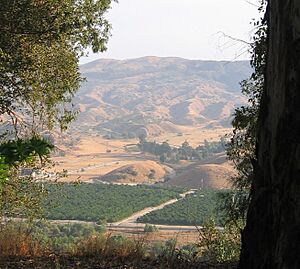San Timoteo Canyon facts for kids

San Timoteo Canyon is a beautiful valley located southeast of Redlands in Southern California. It sits near the San Jacinto Mountains in an area called the Inland Empire.
Contents
Geography of San Timoteo Canyon
This long canyon stretches from Beaumont in Riverside County in the south. It then goes northwest to an area west of Redlands and east of Loma Linda in San Bernardino County.
San Timoteo Creek created the canyon. This creek flows northwest through the valley. It eventually joins the Santa Ana River, which means it's a smaller stream that feeds into a larger one. The creek collects water from the Banning Valley and from the San Bernardino Mountains and San Jacinto Mountains.
History of San Timoteo Canyon
For thousands of years, San Timoteo Canyon was a winter home for the Serrano people. There were also natural hot springs in the area.
In 1819, the San Bernardino de Sena Estancia was built here. It was a ranch outpost for the Mission San Gabriel Arcángel. The mission used it to raise cattle with the help of local Native Americans. Over time, the ranch grew to include a chapel, a place to make tiles, a lime kiln, and a mill for grinding grain.
Later, the canyon became part of Rancho San Bernardino. This was a large land grant given in 1842 by the Mexican governor of Alta California, Juan B. Alvarado. It was given to the Lugo family and Diego Sepulveda.
Native American Leaders and Early Conflicts
In May 1851, an important event happened in San Timoteo Canyon. Juan Antonio, a respected chief of the Mountain Cahuilla people, led his group to confront a gang of outlaws. This gang, led by John "Red" Irving, had been causing trouble and stealing from people in the San Bernardino Valley.
Juan Antonio's Cahuilla village was located on Rancho San Bernardino. The ranch owner, a Californio, asked the Cahuilla for help. The Cahuilla had a long history of helping track down bandits in the region. They were still authorized to act as local law enforcement.
The Cahuilla pursued the gang into San Timoteo Canyon. After a chase, they stopped the outlaws. This action was seen as a way to protect their community.
However, some new American settlers misunderstood what happened. They thought it was the start of a Native American uprising. A group of soldiers from the Presidio of San Diego was sent to confront the Cahuilla. At that time, San Bernardino and Riverside Counties were part of San Diego County.
Juan Antonio's Cahuilla band moved from their village to their homelands in the San Jacinto Mountains. The American leader, Major General Joshua Bean, soon learned the truth. He worked hard to prevent his soldiers from attacking the Cahuilla, which stopped a potential battle.
After this event, in late 1851, Juan Antonio and his people moved eastward. They settled in a village called Saahatpa, which was in a valley branching off San Timoteo Canyon.
In November 1851, a conflict known as the Garra Revolt began. The leader of the Cupeño people, Antonio Garra, tried to get Juan Antonio and the Mountain Cahuilla to join a revolt against the Americans. But Juan Antonio, who had become an ally of the Americans, captured Antonio Garra. He turned him over to American officials, which helped end the revolt.
American Expansion in the Canyon
The famous lawman Wyatt Earp lived in San Timoteo Canyon as a teenager. His family lived there from 1864 to 1868.
In 1877, the Southern Pacific Railroad built its tracks through the canyon. This was part of a new route connecting Los Angeles and Southern California to the eastern United States.
In the mid-1950s, San Timoteo Canyon was considered as a possible path for Interstate 10. This was part of the new Interstate Highway System. However, a route through Redlands was chosen instead.
Parks in San Timoteo Canyon
San Timoteo Canyon State Park
The San Timoteo Canyon State Park is currently being developed. It is not yet open to the public. In 2001, part of the canyon was protected as a regional park. This was thanks to efforts by groups like the Riverside Land Conservancy. Later, it came under the care of the California State Parks department.
When the park opens, it will provide much-needed open space for the growing Inland Empire area. Visitors will be able to enjoy trails for hiking and horseback riding. The park will also protect the many different native plants and animals that live in the canyon. It will also feature historical places, like the San Timoteo Schoolhouse.
San Timoteo Canyon Schoolhouse
The San Timoteo Canyon Schoolhouse is now a museum and park. It is managed by the Riverside County Parks department. The schoolhouse was built in 1883. It was added to the National Register of Historic Places on January 19, 2001.
Riverside County Parks bought the schoolhouse in 1993. It opened to the public after 2007, once a five-year restoration project was finished.
Fossils Discovered in the Canyon
In 2010, a construction crew made an exciting discovery in San Timoteo Canyon. They found a large collection of prehistoric animal fossils. These fossils date back 1.4 million years ago, to the Quaternary Period.
The discovery included nearly 1,500 well-preserved bone fragments. Among them were bones from:
- A giant cat, which was an ancestor of the saber-toothed tiger.
- Ground sloths, which were as big as modern-day grizzly bears.
- Two different types of camels.
- More than 1,200 bones from small rodents.
Other finds included new species of deer, horse, and possibly llama.

